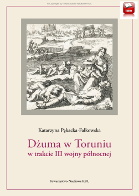Dżuma w Toruniu w trakcie III wojny północnej
The Plague in Toruń during the Great Northern War
Author(s): Katarzyna Pękacka-Falkowska
Subject(s): History, Modern Age, 18th Century
Published by: Towarzystwo Naukowe Katolickiego Uniwersytetu Lubelskiego Jana Pawła II
Keywords: Great Northern War; Toruń; plague
Summary/Abstract: The book attempts to depict the plague in the city of Toruń (Royal Prussia) in years 1708–1711 in its entirety, and accordingly analyses the epidemic as an event which “permeates all the people of a society.” The author argues, that the plague in early modern Toruń was a total social fact and had numerous implications throughout local society, in the economic, juridical, cultural, aesthetic, political, and religious spheres, weaving together diverse strands of social and psychological life.The book consists of two main parts. The first part is descriptive and serves as a chronicle of the destructive plague that broke out in the city in 1708; it traces the ebb and flow of epidemic. Among others, the author discusses the circulation of information between collective and individual actors, and numerous activities of a magistrate of Toruń intending to control the arrival and spread of the disease and to mitigate its negative effects. Also, the mechanisms and processes of normalisation of social and individual life after the catastrophe are presented, together with the persistence of an indelible mark engraved by the disease in the collective memory of city dwellers. The first part of the book conclusively shows that the plague in Toruń in 1708–1711 permeated all spheres of social and individual life in the local community.The second, analytical part of the monograph consists of four chapters. In the first chapter, the author discusses religiosity in plague-stricken Toruń. She analyzes one of the local plague sermons from the sociological perspective to show that during the plague outbreaks religious, medical and social orders were contentiously overlapping. The sermon Christlicher Patient delivered in 1708 by Ephraim Praetorius, a devout Lutheran, was re-defining a habitual condition of a good Christian during the catastrophe and thus it was helping to guide future actions and behaviours of city dwellers simultaneously disposing them to think in a certain way about both their life and death and about charity and Christian love of neighbour. The second chapter presents the history of local plague hospitals as a complex component of urban responses to recurring epidemics. First and foremost it explains how the local lazaretto in Toruń functioned, how it was subsidized, where was it situated, who (and why) worked there, and what it was like to stay (voluntary and enforced) and die there. It also explains how the local plague fighting system was organized in the 17th and 18th centuries and how it was supported by private individuals and city offices. Consequently, the author argues that Lutheran and Catholic self-help together with new patterns of self-organisation were fundamental for specific forms of social solidarity tempore pestis. The third chapter discusses the burial of plague dead and analyzes demographic effects of the epidemic on size and composition of the city population. Among others, it specifies locations of the plague pits and plague cemeteries in Toruń in 1708–1711. It also estimates plague mortality and introduces Jacques Dupâquier’s method to detect demographic crises in the years 1700-1715 on the basis of the temporal distribution of deaths in all city parishes. The last, fourth chapter discusses an early modern phenomenon of timor pestis (fear of plague) and its components. The author argues that in the early modern period the complex notion of natural and supernatural fear was one of the most important elements of the multifaceted understanding of “pestilence” and how it spread. The numerous examples of timor pestis management taken from both ego-documents and administrative source are cited here.In the Annex to this book, editions of selected primary historical sources referring to plagues in early modern Toruń can be found.
- Print-ISBN-13: 978-83-7306-858-2
- Page Count: 592
- Publication Year: 2019
- Language: Polish
- eBook-PDF
- Table of Content
- Introduction
- Sample-PDF

